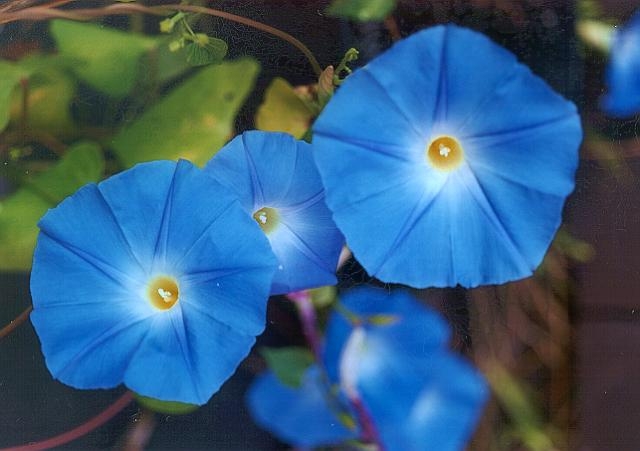Mexican Morning Glory
(Ipomoea tricolor)
Mexican Morning Glory (Ipomoea tricolor)
/
/

Russell E (rkundalini)
CC BY-SA 3.0
Image By:
Russell E (rkundalini)
Recorded By:
Copyright:
CC BY-SA 3.0
Copyright Notice:
Photo by: Russell E (rkundalini) | License Type: CC BY-SA 3.0 | License URL: http://creativecommons.org/licenses/by-sa/3.0/ | Uploader: Sand~commonswiki | Publisher: Wikipedia Commons |







































Estimated Native Range
Summary
Ipomoea tricolor, commonly known as Mexican Morning Glory, is an annual herb or vine native to tropical and subtropical open woodlands and scrub areas in Mexico. It can climb to heights of 2–4 m (7–13 ft) when supported. The plant is renowned for its vibrant, trumpet-shaped flowers that are 4–9 cm (2–4 in) in diameter, most commonly displaying a stunning blue hue with a contrasting white to golden yellow center. These blooms are particularly showy and open in the morning, hence the common name. Flowering occurs from early summer to fall, providing a long season of visual interest.
Mexican Morning Glory is valued for its rapid growth and the spectacular display of its flowers, which can create a sea of blue in the garden. It is often used to cover trellises, fences, and arbors, adding vertical interest to garden spaces. In cultivation, it prefers full sun and well-drained soil, but it is adaptable to various soil types. While it does not tolerate temperatures below 5 °C (41 °F), it thrives in warm climates and is typically grown as an annual in temperate regions. Gardeners should be aware that it can self-seed and become invasive in some areas outside its native range. It is advisable to check local regulations before planting to prevent ecological disruptions.CC BY-SA 4.0
Mexican Morning Glory is valued for its rapid growth and the spectacular display of its flowers, which can create a sea of blue in the garden. It is often used to cover trellises, fences, and arbors, adding vertical interest to garden spaces. In cultivation, it prefers full sun and well-drained soil, but it is adaptable to various soil types. While it does not tolerate temperatures below 5 °C (41 °F), it thrives in warm climates and is typically grown as an annual in temperate regions. Gardeners should be aware that it can self-seed and become invasive in some areas outside its native range. It is advisable to check local regulations before planting to prevent ecological disruptions.CC BY-SA 4.0
Plant Description
- Plant Type: Herb, Vine
- Height: 7.5-15 feet
- Width: 0.5-2 feet
- Growth Rate: Rapid
- Flower Color: Blue, Purple
- Flowering Season: Summer, Fall
- Leaf Retention:
Growth Requirements
- Sun: Full Sun
- Water: Medium
- Drainage: Medium, Fast
Common Uses
Bee Garden, Bird Garden, Butterfly Garden, Hummingbird Garden, Showy Flowers
Natural Habitat
Tropical and subtropical open woodlands and scrub areas in Mexico
Other Names
Common Names: Heavenly-Blue Morning-Glory, Morning-Glory, Grannyvine, Pearly-Gates, Flying-Saucers, Flying Saucers, Pearly Gates, Himmelblaue Prunkwinde, Liane Douce, Ipomée
Scientific Names: , Ipomoea tricolor, Ipomoea rubrocaerulea, Convolvulus rubrocaeruleus, Convolvulus rubrocoeruleus, Convolvulus venustus, Ipomoea hookeri, Ipomoea schiedeana, Pharbitis rubrocaerulea, Pharbitis tricolor,
GBIF Accepted Name: Ipomoea tricolor Cav.